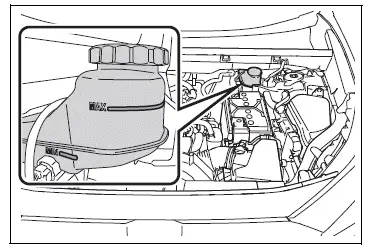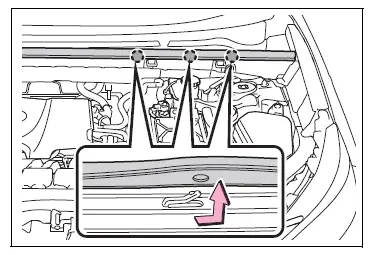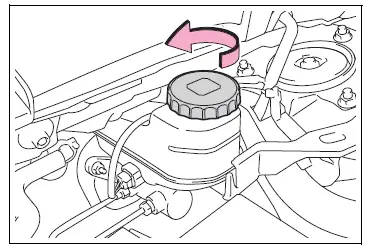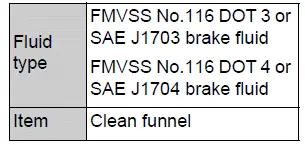Toyota RAV4 (XA50) 2019-2025 Owners Manual: Checking and adding the brake fluid
â– Checking fluid level
The brake fluid level should be between the "MAX" and "MIN" lines on the tank.

â– Adding fluid
1. Slide and lift up the rubber strip to partly remove it as shown.

2. Disconnect the claws and remove the service cover.

3. Remove the reservoir cap.

4. Add brake fluid slowly while checking the fluid level.
Make sure to check the fluid type and prepare the necessary item.

â– Brake fluid can absorb moisture from the air
Excess moisture in the brake fluid can cause a dangerous loss of braking efficiency. Use only newly opened brake fluid.
WARNING
â– When filling the reservoir
Take care as brake fluid can harm your hands and eyes and damage painted surfaces.
If fluid gets on your hands or in your eyes, flush the affected area with clean water immediately.
If you still experience discomfort, see a doctor.
NOTICE
â– If the fluid level is low or high
It is normal for the brake fluid level to go down slightly as the brake pads wear out or when the fluid level in the accumulator is high.
If the reservoir needs frequent refilling, there may be a serious problem.
 Checking the coolant
Checking the coolant
The coolant level is satisfactory
if it is between the "FULL" and
"LOW" lines on the reservoir
when the engine is cold.
Reservoir cap
"FULL" line
"LOW" line
If the level is on or below the "LOW" ...
 Checking the battery
Checking the battery
Check the battery as follows.
â– Battery exterior
Make sure that the battery terminals
are not corroded and that
there are no loose connections,
cracks, or loose clamps.
Terminals
Hold-down clamp ...
Other materials:
Luggage cover (if
equipped)
â– Installing the luggage cover
1. Compress the both ends of
the luggage cover and insert
into the recess to install.
2. Pull out the luggage cover
and hook it onto the anchors.
â– Removing the luggage
cover
1. Release the cover from the
left and right anchors and
allow it to retract.
2. Compre ...
Winter driving tips
Carry out the necessary preparations and inspections before
driving the vehicle in winter. Always drive the vehicle in a manner
appropriate to the prevailing weather conditions.
Preparation for winter
Use fluids that are appropriate to the prevailing outside temperatures.
Engine oil
E ...
Removal
(2006/01- )
Remove front wheel
Drain automatic transaxle fluid
Drain the automatic transaxle fluid for u140f (see
page ax-147).
Drain the automatic transaxle fluid for u241e (see
page ax-146).
Drain the automatic transaxle fluid for u151e (see
page ax-172).
Remove front axle hub nut ( ...
